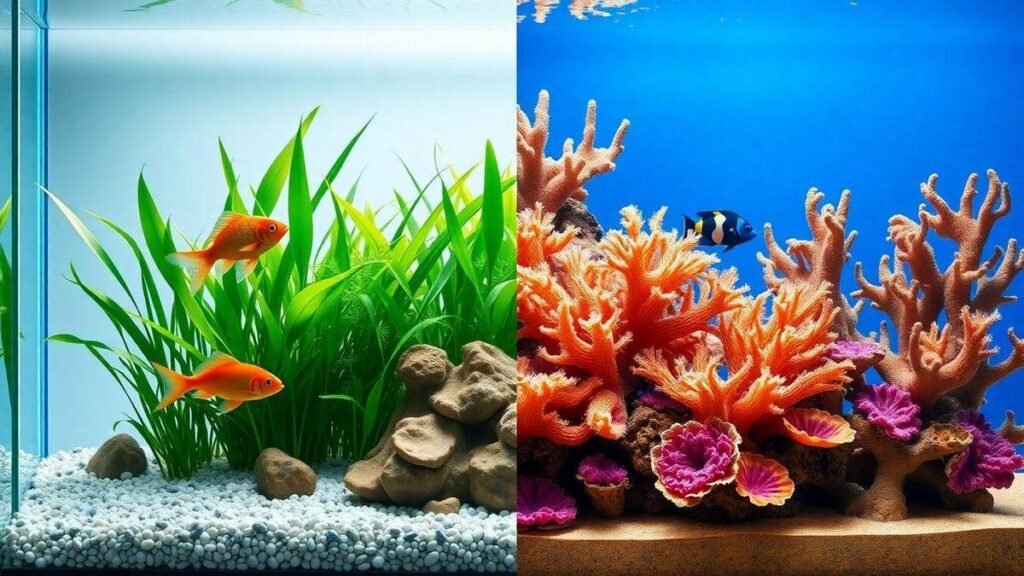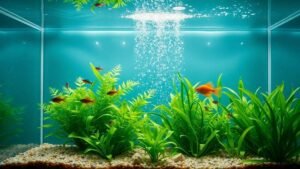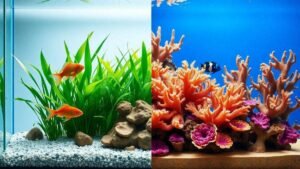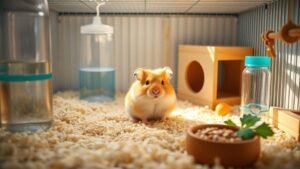As diferenças entre peixes de água doce e água salgada como pets
Choosing between freshwater and saltwater tanks can feel overwhelming. I test salinity and water chemistry with a refractometer, monitor pH, hardness, and ammonia, set up tanks with the right gear, compare startup and running costs, feed proper diets, quarantine new fish, and watch for disease. I match compatibility, plan for different breeding needs, and keep conditions steady so fish thrive.
Key takeaway
- Freshwater is generally easier and cheaper to care for — see freshwater fish care and tank tips for setup and maintenance guidance.
- Saltwater demands more stable, exact water conditions and testing.
- Freshwater tanks often use live plants and simpler setups.
- Saltwater fish and reef animals are more sensitive to water swings.
- Choose based on time, budget, and how much precise care you want — review a general guide to caring for pets if you’re comparing commitments across pet types.
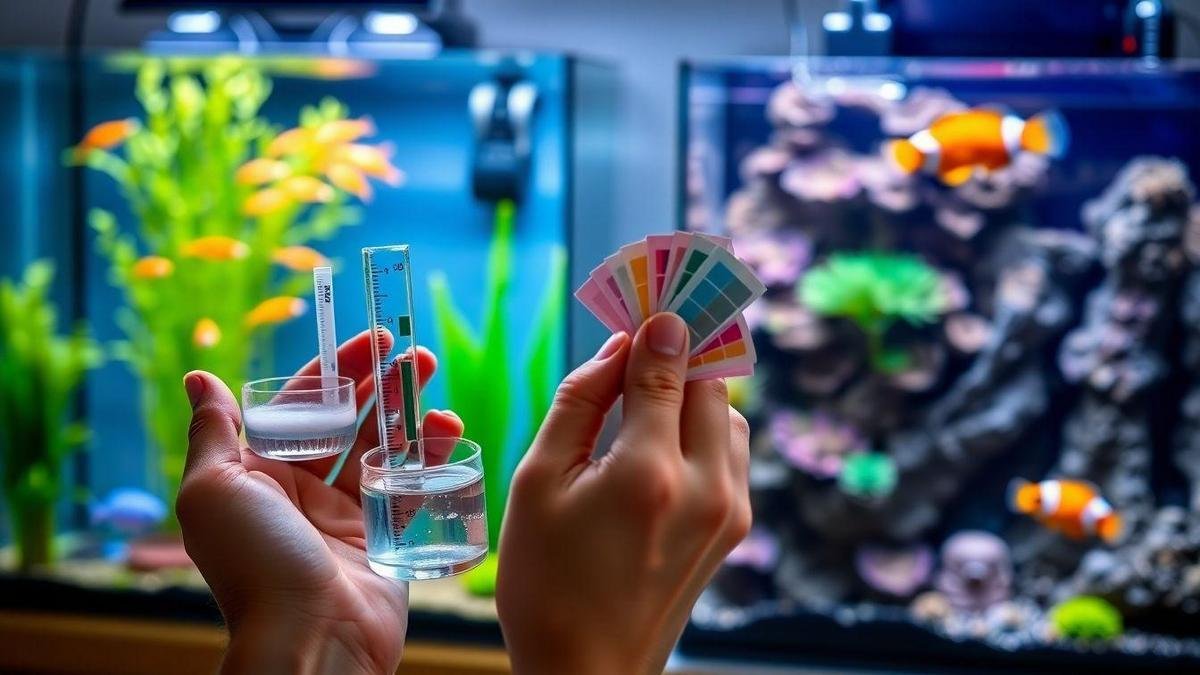
How I test salinity and water chemistry for As diferenças entre peixes de água doce e água salgada como pets
I track salinity with a refractometer
I use a refractometer for quick, clear salinity (SG) reads. Calibrate with distilled water, place a drop on the prism, and log each reading. Early in my saltwater experience I learned to test daily—evaporation can raise SG quickly, and catching that saved fish.
Salinity at a glance:
| Type of tank | Typical salinity (ppt) | Specific Gravity (SG) |
|---|---|---|
| Freshwater | ~0 | ~1.000 |
| Brackish | 1–15 ppt | 1.005–1.018 |
| Marine (fish-only) | 30–35 ppt | 1.020–1.026 |
| Marine (reef) | 35 ppt | 1.025–1.026 |
I monitor pH, hardness and ammonia
I test pH, KH, GH, and ammonia with liquid kits and a digital pH meter. Test more often after changes or new additions.
Target ranges I watch:
| Parameter | Freshwater target | Saltwater target |
|---|---|---|
| pH | 6.5–7.5 | 8.1–8.4 |
| KH (carbonate) | 3–8 dKH | 7–12 dKH |
| GH (general) | 4–12 dGH | ~8–12 dGH |
| Ammonia | 0 ppm | 0 ppm |
If ammonia rises above 0.25 ppm I act fast: partial water changes, pause feedings, and check filtration.
Steps I take to keep parameters stable
- Use RO/DI water for top-offs to avoid unwanted minerals.
- Mix salt in a separate bucket and match temperature and SG before adding.
- Do regular partial water changes (I do 10–20% weekly).
- Use an auto top-off or check evaporation daily.
- Keep a log of readings and changes.
Stability reduces stress and disease—small, steady adjustments beat big swings.
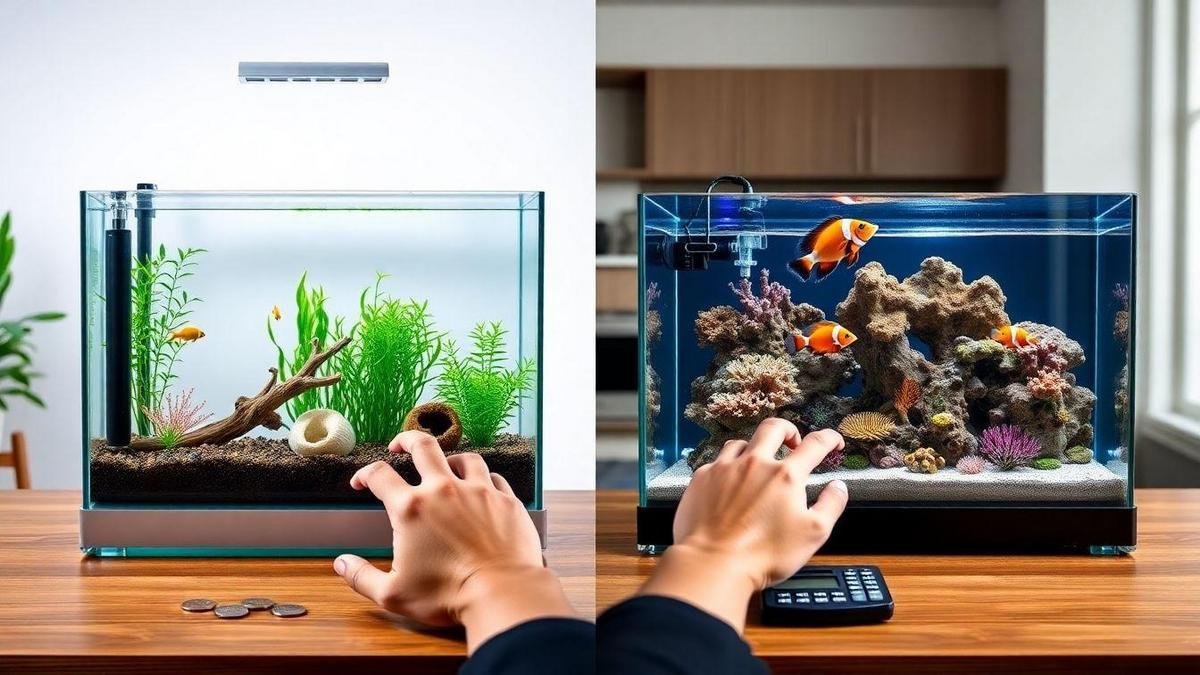
How I set up tanks and compare startup & running costs for As diferenças entre peixes de água doce e água salgada como pets
I started small and learned fast. Below are the gear choices and cost comparisons I use when deciding between freshwater and saltwater.
Gear differences: what I choose
- Saltwater: protein skimmer, live rock, a sump, quality salt mix, stronger lighting for corals, heater with controller.
- Freshwater: reliable filter, stable heater, simple substrate, water conditioner, gentle lighting.
The right gear reduces maintenance and stabilizes water chemistry. When planning where to place and run equipment, consider room layout and safety — a pet-friendly indoor space helps keep equipment accessible and pets safe.
Startup and running costs (approximate)
| Item | Freshwater (small–medium) | Saltwater (small–medium reef) |
|---|---|---|
| Tank stand | $30–$200 | $100–$800 |
| Filtration | $20–$150 | $100–$400 (sump, skimmer) |
| Lighting | $20–$150 | $200–$800 |
| Live rock / substrate | $10–$80 | $100–$300 |
| Salt, test kits, additives | $10–$50 | $50–$150 |
| Total startup (typical) | $90–$630 | $650–$2,450 |
| Monthly running | $5–$20 | $30–$100 |
| Weekly time | 15–60 min | 30–120 min |
Saltwater systems cost more up front and require more monthly supplies and time. Freshwater is cheaper and simpler to run.
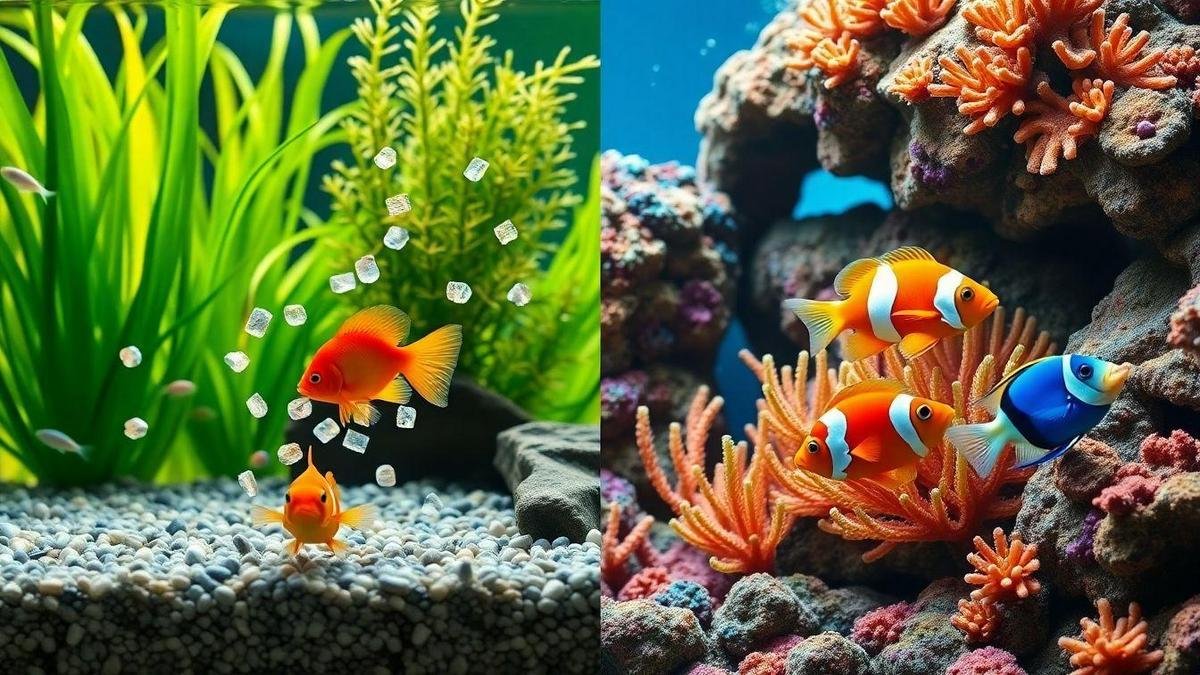
How I feed and meet freshwater vs saltwater fish diet needs
Food choices
- Saltwater: marine-based proteins (mysis, krill), small fish pieces, algae/seaweed for herbivores.
- Freshwater: high-quality flakes and pellets, occasional frozen/live foods (brine shrimp, bloodworm).
Food table:
| Tank type | Common food types | Examples | How often I feed |
|---|---|---|---|
| Saltwater | Marine proteins, algae | Mysis, krill, seaweed sheets | 1–2× daily; small portions |
| Freshwater | Flakes, pellets, live/frozen | Tropical flakes, cichlid pellets, brine shrimp | 1–2× daily; measure by mouths |
A coral tank and a community freshwater tank feed differently—observe and adjust.
Avoid overfeeding
- Feed only what fish eat in ~2 minutes.
- Use a feeding ring or syringe for precision.
- Remove uneaten food quickly with a net or siphon.
- Test ammonia, nitrite, nitrate regularly and adjust portions.
Saltwater systems are generally more sensitive to waste—be especially conservative there.
Frozen and live foods for marine species
Many marine species prefer frozen or live prey. I keep thawed mysis and brine shrimp on hand, thaw in tank water, and feed small portions. For live food, buy from trusted sources and quarantine to avoid pests.
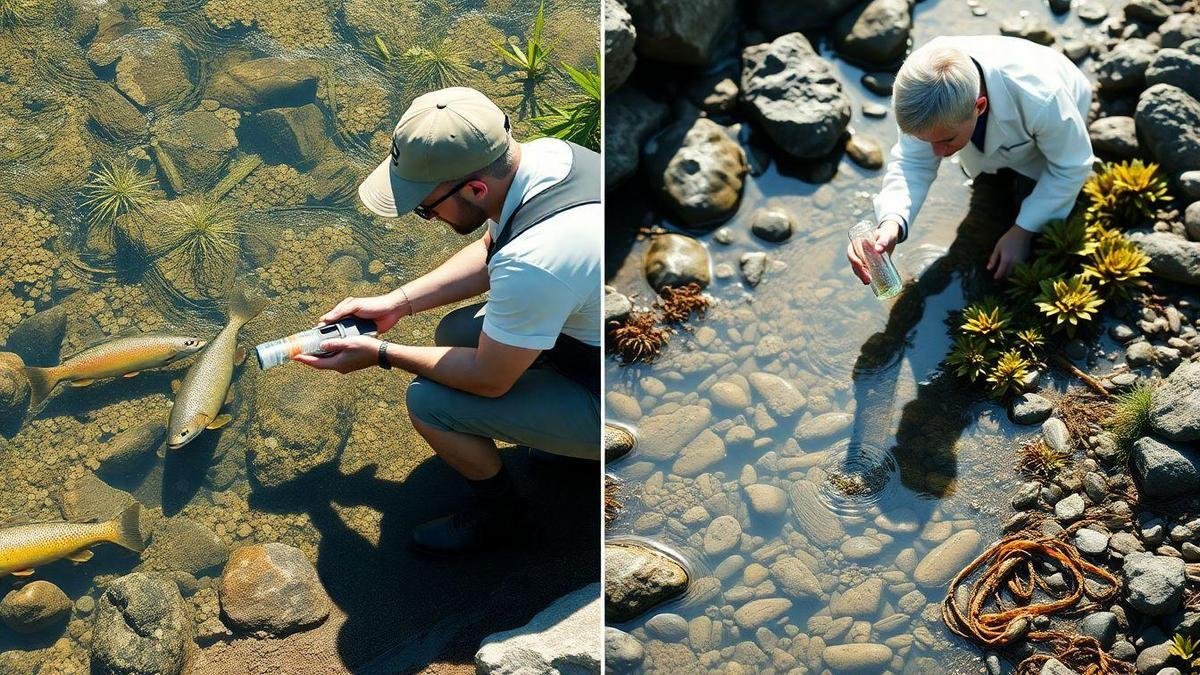
How I reduce disease risk by understanding susceptibility — As diferenças entre peixes de água doce e água salgada como pets
Understanding how freshwater and saltwater systems differ is key to preventing disease. I use the phrase As diferenças entre peixes de água doce e água salgada como pets to remind myself that care changes with the type of fish.
Common freshwater pathogens I watch for
Look for white spots, frayed fins, hiding, and loss of appetite—signs of ich or bacterial infections. Poor water quality often invites disease.
| Pathogen | Common signs | Quick action I take |
|---|---|---|
| Ich (Ichthyophthirius) | White spots, scratching | Raise temp slightly, possible salt dip, medicate if needed |
| Fin rot (bacterial) | Faded or torn fins | Improve water quality, medicated baths |
| Fungal | Cottony growths | Remove affected material, antifungal treatment |
Marine issues: ich, velvet, nitrification failures
Marine tanks show issues like marine ich, velvet (Amyloodinium), and sensitivity to nitrification failures.
| Marine issue | Signs | What I do |
|---|---|---|
| Marine ich | Tiny white specs, flashing | Quarantine, hyposalinity dips for some species, meds |
| Velvet | Gold-dust sheen, gasping | Copper or formalin treatments where appropriate |
| Nitrification failure | Ammonia/nitrite spikes | Test water, large water change, add nitrifying bacteria |
Quarantine and weekly checks
I quarantine new fish for 2–4 weeks and keep a small quarantine tank ready. Weekly checklist:
- Test ammonia, nitrite, nitrate, pH, temperature.
- Check salinity for saltwater tanks.
- Observe fish behavior for 5 minutes daily.
Parameter targets:
| Parameter | Freshwater target | Saltwater target |
|---|---|---|
| Ammonia | 0 ppm | 0 ppm |
| Nitrite | 0 ppm | 0 ppm |
| Nitrate | < 20 ppm | < 20 ppm (reef lower) |
| pH | 6.5–7.8 (species dependent) | 8.0–8.4 |
| Salinity | N/A | 1.023–1.026 (SG) |
Quarantine plus routine testing stops most outbreaks before they reach the main tank. For broader pet-care standards that complement aquarium hygiene and biosecurity, consider this checklist on whether you’re giving your pet the care they deserve.

How I choose compatible species and manage compatibility — As diferenças entre peixes de água doce e água salgada como pets
The differences between freshwater and marine species affect temperament, size, reef compatibility, and aggression. I treat this as planning a small community: everyone must fit the niche.
Research temperament, size, reef compatibility
I read profiles and watch videos to learn a fish’s temperament, adult size, and whether it is reef-safe. Avoid mixing large territorial species with small peaceful ones. For species like a betta, or other fish with special social needs, follow specific care guidance such as the betta care tips for community tanks to prevent aggression and stress.
Quick comparison:
| Factor | Freshwater examples | Saltwater examples |
|---|---|---|
| Temperament | Peaceful (tetras) or semi-aggressive (cichlids) | Ranges from shy (clownfish) to territorial (some filefish) |
| Size at adult | Small–medium (1–8 in) | Small to large (1–12 in) |
| Reef compatibility | Many fine with plants; some eat plants | Some reef-safe, others nip corals or invertebrates |
| Aggression risk | Medium in community tanks | Can be high with territorial species |
Match social needs: schooling fish in groups; territorial fish given space and caves.
Habitat structure and hiding places
Arrange the tank like a neighborhood:
- Provide shelter for shy species.
- Leave open space for mid-water swimmers.
- Add gentle current for species that like flow.
- Use appropriate substrate for bottom-dwellers.
I never mix freshwater and marine species—salinity and diets differ too much. They require separate tanks.
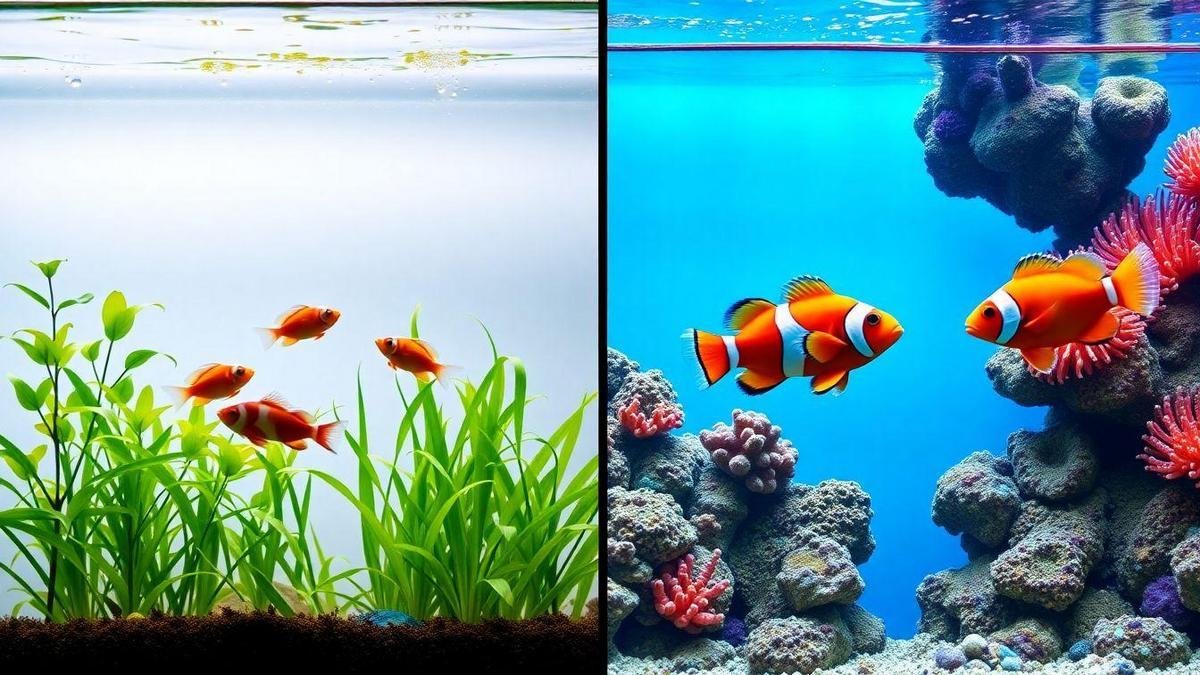
How I approach breeding — differences in breeding freshwater vs saltwater fish
Freshwater breeding (easier & cheaper)
I set up a small spawning tank (10–20 gal), use a sponge filter, steady heater, hiding spots, and spawning mops or plants. For livebearers I use breeding boxes or dense plants. Fry are fed infusoria, crushed flakes, or baby brine shrimp—freshwater fry accept these easily and survival improves with stable water.
| Item | Freshwater approach | What I watch for |
|---|---|---|
| Tank size | 10–20 gal starter | Stable temp, low flow |
| Filtration | Sponge filter | No strong currents |
| Fry food | Infusoria, crushed flakes, BBS | Food size matters |
| Cost | Lower | Fewer special supplies |
Marine breeding (complex larval stages)
Marine breeding often needs live plankton (rotifers, copepod nauplii), kreisel or gentle flow tanks, and algal cultures. I culture rotifers and microalgae ahead of time, maintain daily checks on salinity and temperature, and accept a steeper learning curve and higher cost.
Marine breeding steps:
- Rear brood with excellent nutrition.
- Hatch/culture rotifers and Brachionus ahead of time.
- Use kreisel or circular flow to keep larvae suspended.
- Move larvae to grow-out tanks as they grow.
Freshwater breeding gives quicker wins; marine breeding offers deeper challenges and rewards.
Conclusion
Choosing between freshwater and saltwater depends on time, budget, and how much precise care you want to give. For me, freshwater is gentler—cheaper to start, easier to run, and forgiving. Saltwater is rewarding but requires stability, extra testing, and specialized gear. Remember: regular testing (salinity, pH, ammonia), strict quarantine, measured feeding, and choosing compatible species keep tanks healthy. Breeding is usually simpler in freshwater; marine breeding often needs live plankton and special setups.
If you’re unsure, start small, learn as you go, and let success build confidence. The phrase As diferenças entre peixes de água doce e água salgada como pets summarizes why care differs so much between these two worlds.
Find additional resources across the site on all posts, learn more about the site on our About Us page, or get in touch via our contact page.
For more tips and how-tos, visit https://blogcraelo.com.
Frequently asked questions
What are the main differences between freshwater and saltwater pet fish?
Freshwater fish live in low-salt water and are generally easier to keep. Saltwater fish require stable salinity, different gear (protein skimmers, live rock), and more testing. In short: salt level, gear, and cost differ—As diferenças entre peixes de água doce e água salgada como pets capture that.
Which type is easier for a beginner?
Freshwater. It needs less gear, lower startup cost, and is more forgiving for small mistakes.
How does cost compare?
Freshwater setups are cheaper up front and monthly. Saltwater requires higher startup costs (sump, skimmer, lighting) and higher ongoing expenses.
Do they need different tanks and equipment?
Yes. Saltwater needs salt mix, protein skimmers, and different test kits. Freshwater needs simpler filters, conditioners, and decor.
Can I keep freshwater and saltwater fish together?
No. Salinity and chemistry are incompatible and mixing them will harm or kill the animals. Keep separate tanks for each.

